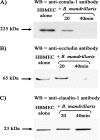Increasing importance of Balamuthia mandrillaris
- PMID: 18625680
- PMCID: PMC2493082
- DOI: 10.1128/CMR.00056-07
Increasing importance of Balamuthia mandrillaris
Abstract
Balamuthia mandrillaris is an emerging protozoan parasite, an agent of granulomatous amoebic encephalitis involving the central nervous system, with a case fatality rate of >98%. This review presents our current understanding of Balamuthia infections, their pathogenesis and pathophysiology, and molecular mechanisms associated with the disease, as well as virulence traits of Balamuthia that may be potential targets for therapeutic interventions and/or for the development of preventative measures.
Figures





References
-
- Alsam, S., K. S. Kim, M. Stins, A. O. Rivas, J. Sissons, and N. A. Khan. 2003. Acanthamoeba interactions with human brain microvascular endothelial cells. Microb. Pathog. 35:235-241. - PubMed
-
- Amaral-Zettler, L. A., T. A. Nerad, C. J. O'Kelly, M. T. Peglar, P. M. Gillevet, J. D. Silberman, and M. L. Sogin. 2000. A molecular reassessment of the leptomyxid amoebae. Protist 151:275-282. - PubMed
-
- Anzil, A. P., R. Chandrakant, M. A. Wrzolek, G. S. Visvesvara, J. H. Sherand, and P. B. Kozlowski. 1991. Amebic meningoencephalitis in a patient with AIDS caused by a newly recognized opportunistic pathogen. Arch. Pathol. Lab. Med. 115:21-25. - PubMed
-
- Armao, D., M. Kornfeld, E. Y. Estrada, M. Grossetete, and G. A. Rosenberg. 1997. Neutral proteases and disruption of the blood-brain barrier in rat. Brain Res. 5:259-264. - PubMed
-
- Bakardjiev, A., P. H. Azimi, N. Ashouri, D. P. Ascher, D. Janner, F. L. Schuster, G. S. Visvesvara, and C. Glaser. 2003. Amoebic encephalitis caused by Balamuthia mandrillaris: report of four cases. Pediatr. Infect. Dis. J. 22:447-452. - PubMed
Publication types
MeSH terms
LinkOut - more resources
Full Text Sources

